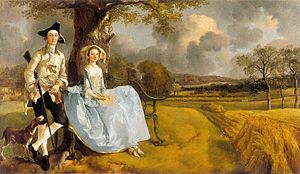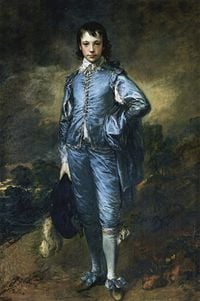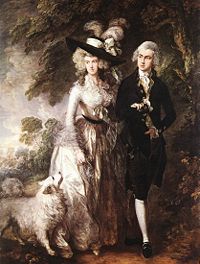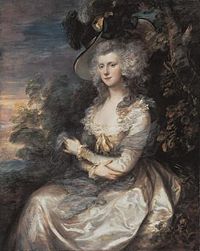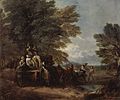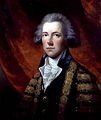Gainsborough, Thomas
David Doose (talk | contribs) m |
David Doose (talk | contribs) m |
||
| Line 25: | Line 25: | ||
He was among the most innovative and enigmatic artists of his age. While some of his work was influenced by [[van Dyck]] and [[Peter Paul Rubens]], his landscapes, portraits and fancy pictures also show the work of an independent and original genius. | He was among the most innovative and enigmatic artists of his age. While some of his work was influenced by [[van Dyck]] and [[Peter Paul Rubens]], his landscapes, portraits and fancy pictures also show the work of an independent and original genius. | ||
| − | He is considered the most creative and adventurous artist in England between [[Hogarth]] and [[Turner]] and a link between them. He also had an influence on the work of [[Constable]]. His artistic life was a continuous struggle to get away from the portraiture that gave him a living ("the drudgery of face-painting", as he called it) and to immerse himself in the genre of landscapes that was just emerging as a public favorite. | + | He is considered the most creative and adventurous artist in England between [[Hogarth]] and [[Turner]] and a link between them. He also had an influence on the work of [[Constable]]. His artistic life was a continuous struggle to get away from the portraiture that gave him a living ("the drudgery of face-painting", as he called it) and to immerse himself in the [[Genres|genre]] of landscapes that was just emerging as a public favorite. |
==Life== | ==Life== | ||
Revision as of 18:39, 19 October 2008
- This article is about the artist Thomas Gainsborough. Gainsborough is also the name of a small market town in Lincolnshire in England.
| Thomas Gainsborough | |
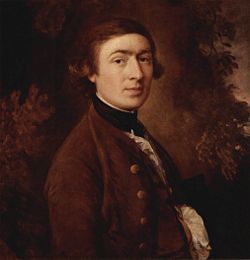 Self-portrait, painted 1759 | |
| Birth name | Thomas Gainsborough |
| Born | May 14 1727 (baptized) Sudbury, Suffolk, England |
| Died | August 2 1788 (aged 61) |
| Nationality | English |
| Field | Painter |
| Famous works | Mr and Mrs Andrews The Blue Boy |
Thomas Gainsborough (christened May 14, 1727 – August 2, 1788) was one of the most famous portrait and landscape painters of 18th century Britain.
He was among the most innovative and enigmatic artists of his age. While some of his work was influenced by van Dyck and Peter Paul Rubens, his landscapes, portraits and fancy pictures also show the work of an independent and original genius.
He is considered the most creative and adventurous artist in England between Hogarth and Turner and a link between them. He also had an influence on the work of Constable. His artistic life was a continuous struggle to get away from the portraiture that gave him a living ("the drudgery of face-painting", as he called it) and to immerse himself in the genre of landscapes that was just emerging as a public favorite.
Life
Suffolk
Gainsborough was born in Sudbury, Suffolk, England. His father was a weaver involved with the wool trade. Both Gainsborough and Constable grew up in the Stour Valley, running between Essex and Suffolk,in Sudbury there are watermeadows and further down in Constable country there are broader lands for crops. Constable worked directly in the country all his life whilst Gainsborough took a different tack yet never forgetting the bucolic views of his youth. Constable was to remark in 1799, that, 'It is the most delightful country for a painter, I fancy I see Gainsborough in every hedge and hollow tree.' Gainsborough is quoted as saying 'Old pimply-nosed Rembrandt and myself were both born in a mill.' Not strictly true but his father did own a large Tudor house that had once been an inn. Being a textile manufacturer he needed the space for looms etc. There was a fairly large family and Tom led an uneventful young life but always took pleasure in wandering the banks of the river. His mother had a well-cultivated mind and excelled in flower painting encouraging Tom when he showed an aptitude for drawing. It is thought that he may have seen some prints of Dutch landscapes that he later came to revere and they may have had some influence but it was probably his mother who inspired his father with his penciling skills. At the age of thirteen, in 1740, he let him go to London to study initially as a silversmith. His uncle had made some provision for Thomas so it's possible that this payed his way.
London, briefly
It was said that all the time that he was in London, from the age thirteen, he was of no expense to his father. At some p[oint Thomas left the silversmith and instead first trained under engraver Hubert Gravelot but eventually became associated with a collection of avant-garde painters centered around William Hogarth and the Academy at St. Martin's Lane. He began painting and skill seemed to come naturally to him and he was soon hired by art dealers to repair old paintings. This gave him a chance to study foreign artists in particular, the Dutch 17th century landscape painters, Jacob van Ruisdael and Jan Wynants. He would also have seen French and Italian work. On the one hand, the realism of the Dutch and on the other the Rococo curves. One of his mentors was Francis Hayman. This artist was famous for his scenes from Shakespeare and also painted scenery for the theater. William Hogarth promoted the concept of public art and Thomas contributed to the decoration of what is now the Thomas Coram Foundation for Children and joined Hayman's team painting the supper boxes at Vauxhall Gardens. It was said that Hayman may have had a bad influence, introducing him to drinking in the taverns and chasing women, or 'petticoat reading'. This seemed to become a life-long habit and very different from another great portrait artist, Joshua Reynolds who at the same time was studying under Thomas Hudson but who was a little older and more prudent being more purposeful rather than intuitive. Gainsborough seemed to have tried his hand at a manner of things; selling drawings or small landscape paintings for small sums to the dealers and even sculpting figures of animals, maybe in clay, a signed plaster cast of an old horse found it's way to John Constable at some point. According to one story and during one of his visitations home to Sudbury, Thomas met a young lady whilst out sketching and she entered his picture and his life. Said to be quite pretty he began her portrait and after many sittings, she, on seeing a job well done, hinted that he might become the possessor of the original. Although this is a romantic notion it was more likely that they were introduced by her brother and during portrait sittings, he wooed her.
On July 15, 1746, in Mayfair, London, Thomas Gainsborough married Margaret Burr, possibly an illegitimate daughter of the 3rd Duke of Beaufort, who'd settled a £200 annuity on her and which greatly helped the young couple. This was a handsome sum for the time but the artist's work, then mainly composed of landscape paintings, was not selling very well. However this meant that the young artist was never forced to earn a living with his painting in his youth and felt free to explore the countryside, making sketches for paintings and paint delightful portraits of his children and friends and never stick to the rigidity of conventional portrait art. He would often give work away or sell for a low price. Tom was free to experiment and follow his instincts. Even when he'd won commercial success, in later life, he still retained that youthful quality, changeable and gay.
Suffolk again
He returned to Sudbury in 1748–1749 and concentrated on the painting of portraits.
Sudbury could not sustain an artist even with his contacts and so in 1752, he and his family, now including two daughters, moved to Ipswich. This was a more cultured environment and he was able to socialize with musicians being a keen instrumentalist himself. Commissions for personal portraits increased, with landscapes for the Duke of Bedford and a portrait of Admiral Vernon but his clientel included mainly local merchants and squires. His time in the country had been well spent, however, with his studies of nature and landscapes now influenced somewhat by foreign fashions, some of which were the bucolic French contemporary artists such as Boucher. He also paid attention to his own family with a group sitting which showed the direction he was going in the treatment of the nature surrounding them. His portraits of his young daughters are thought to be the some of the loveliest in all art and he never put them up for sale. Now finding not enough worrk to sustain them, he had to borrow against his wife's annuity and made an exploratory trip to Bath in autumn of 1758 and finally moved there. He was not unprepared and had made sure potential patrons would be impressed with his cosmopolitan sophistication. He had been studying a new French pastel technique used by portraitist Allan Ramsey (1713-1784) that produced a surface unlike the 'licked' portaiture of Reynolds and others.
Bath
In 1759, Gainsborough and his family moved to Bath. The commissions came quickly and within a year he was well-known. His efforts had born fruit. The Poet Laureate, William Whitehead noted, "We have a painter here that takes the most exact likenesses I ever saw, his painting is coarse and slight, but has ease and spirit'. The years in Bath saw his artistic maturation as he mastered his medium. However he also experimented in his imagery and techniques. There he concentrated his study of portraits by van Dyck and was eventually able to attract a better-paying high society clientele. He was at the heart of the newly created luxury culture and Bath was second only to London in leading the way. He was able to paint high society at it's most fashionable and mix with his favorite musicians and theatricals. In 1761, he began to send work to the Society of Arts exhibition in London (now the Royal Society of Arts, of which he was one of the earliest members); and from 1769 on, he submitted works to the Royal Academy's annual exhibitions. He selected portraits of well-known or notorious clients in order to attract attention. These exhibitions helped him acquire a national reputation, and he was invited to become one of the founding members of the Royal Academy in 1769. His relationship with the academy, however, was not an easy one and he stopped exhibiting his paintings there in 1773.
London
In 1774, Gainsborough and his family moved to London to live in Schomberg House, Pall Mall. In 1777, he again began to exhibit his paintings at the Royal Academy, including portraits of contemporary celebrities, such as the Duke and Duchess of Cumberland. Exhibitions of his work continued for the next six years.
In 1780, he painted the portraits of King George III and his queen and afterwards received many royal commissions. This gave him some influence with the Academy and allowed him to dictate the manner in which he wished his work to be exhibited. However, in 1783, he removed his paintings from the forthcoming exhibition and transferred them to Schomberg House.
In 1784, royal painter Allan Ramsay died and the King was obliged to give the job to Gainsborough's rival and Academy president, Joshua Reynolds, however Gainsborough remained the Royal Family's favorite painter. At his own express wish, he was buried at St. Anne's Church, Kew, where the Family regularly worshipped.
In his later years, Gainsborough often painted relatively simple, ordinary landscapes. With Richard Wilson, he was one of the originators of the eighteenth-century British landscape school; though simultaneously, in conjunction with Joshua Reynolds, he was the dominant British portraitist of the second half of the 18th century.
Art and commentary
Gainsborough painted more from his observations of nature (and human nature) than from any application of formal academic rules. The poetic sensibility of his paintings caused Constable to say, "On looking at them, we find tears in our eyes and know not what brings them." He himself said, "I'm sick of portraits, and wish very much to take my viol-da-gam and walk off to some sweet village, where I can paint landskips (sic) and enjoy the fag end of life in quietness and ease."
His most famous works, such as Portrait of Mrs. Graham; Mary and Margaret: The Painter's Daughters; William Hallett and His Wife Elizabeth, nee Stephen, known as The Morning Walk; and Cottage Girl with Dog and Pitcher, display the unique individuality of his subjects.
Gainsborough's only known assistant was his nephew, Gainsborough Dupont.
He died of cancer on 2 August 1788 in his 62nd year.
Legacy
Gallery
- Viol Abel TGainsborough1765.jpg
Retrato do compositor Carl Friedrich Abel, com sua viola da gamba, 1765
In Fiction
- Kitty (1945) is a notable fictional film about Gainsborough, portrayed by Cecil Kellaway.
- Gainsborough has an important posthumous role in the alternate history novel The Two Georges by Harry Turtledove.
- In Darwyn Cooke's revival of the classic comic book series The Spirit, heroine Silk Satin nicknames the eponymous protagonist "Gainsborough" because of his blue outfit, in a silly reference to Gainsborough's most famous painting.
Notes
ReferencesISBN links support NWE through referral fees
- Belsey, Hugh, and Thomas Gainsborough. 2002. Thomas Gainsborough: A Country Life. New York: Prestel. ISBN 3791327844
- Hayes, John T., and Thomas Gainsborough. 1980. Thomas Gainsborough. London: Tate Gallery. ISBN 0905005724
- Hayes, John T., and Thomas Gainsborough. 1971. The Drawings of Thomas Gainsborough. New Haven: Published for the Paul Mellon Centre for Studies in British Art (London) by Yale University Press. ISBN 0300014252
- Lindsay, Jack. 1981. Thomas Gainsborough: His Life and Art. New York: Universe Books. ISBN 0876633521
- Postle, Martin. 2002. Thomas Gainsborough. British artists. Princeton, N.J.: Princeton University Press. ISBN 0691114595
- Waterhouse, Ellis Kirkham. 1966. Gainsborough. London: Spring Books. OCLC 186019
External links
- Webmuseum Paris: Thomas Gainsborough. Retrieved May 3, 2008.
- Gainsborough's Showbox. Paintings & Drawings. Victoria and Albert Museum. Retrieved May 3, 2008.
Credits
New World Encyclopedia writers and editors rewrote and completed the Wikipedia article in accordance with New World Encyclopedia standards. This article abides by terms of the Creative Commons CC-by-sa 3.0 License (CC-by-sa), which may be used and disseminated with proper attribution. Credit is due under the terms of this license that can reference both the New World Encyclopedia contributors and the selfless volunteer contributors of the Wikimedia Foundation. To cite this article click here for a list of acceptable citing formats.The history of earlier contributions by wikipedians is accessible to researchers here:
The history of this article since it was imported to New World Encyclopedia:
Note: Some restrictions may apply to use of individual images which are separately licensed.
